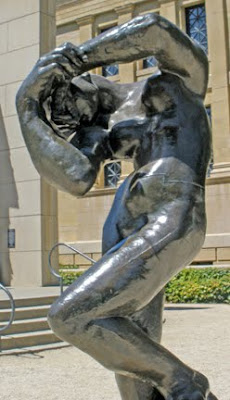
Little in Rodin’s early years suggested that he would become
the most celebrated artist of his day.
the most celebrated artist of his day.

His application to the Ecole des Beaux Arts was rejected three times, so he
received his artistic training at a less prestigious school that trained
craftsmen rather than at one that trained fine artists.
received his artistic training at a less prestigious school that trained
craftsmen rather than at one that trained fine artists.

From 1870 to 1877 the young sculptor refined his skills in Brussels where he was employed carving decorative embellishments for public buildings and monuments.

He also created his own works, and one of these, The Age of Bronze, finally brought him
to public notice. When he presented it for exhibition at the 1877 Paris Salon, the
statue was considered so lifelike that he was accused of having made a cast
of a living person, rather than modeling the figure.
to public notice. When he presented it for exhibition at the 1877 Paris Salon, the
statue was considered so lifelike that he was accused of having made a cast
of a living person, rather than modeling the figure.

The scandal brought him notoriety, and thereafter Rodin’s career flourished. He received a succession of public and private commissions including The Gates of Hell (1880) and monuments to the Burghers of Calais (1885), the painter Claude Lorrain (1888),
and the writers Victor Hugo (1889) and Honore de Balzac (1891).
and the writers Victor Hugo (1889) and Honore de Balzac (1891).

The originality of Rodin’s work inevitably provoked controversy,
and this critical attention brought him world renown.
and this critical attention brought him world renown.

He nurtured is reputation through exhibitions, interviews, and photographs.

He welcomed his induction into the Legion of Honor, and helped arrange for
the establishment of the Rodin Museum in Paris, which was approved
by a vote of the National Assembly a year before his death.
the establishment of the Rodin Museum in Paris, which was approved
by a vote of the National Assembly a year before his death.

This extraordinary level of public recognition is all the more remarkable
given the revolutionary character of his accomplishment.
given the revolutionary character of his accomplishment.

Rodin frequently challenged the public through the passion infused in his works, and his remarkable capacity to discard traditional ideas of beauty, expression, imitation and finish
as he struggled to invent ever more effective ways to convey his ideas.
as he struggled to invent ever more effective ways to convey his ideas.

The Gates of Hell

We also went inside the museum, and I took a few photos there.

Extraordinary! Remarkable! Life like! All words that may be
used to describe his sculptured heads, like this one ...
used to describe his sculptured heads, like this one ...

... and this.

A bit of humor --
Losing one glove is certainly painful,
but nothing compared to the pain of losing one,
throwing away the other,
and then finding the first one again.
Big art. So Rodin didn't make 3 inch sculptures? I remember seeing Rembrandt's The Night Watch painting and being surprised it didn't fit on an 8.5"x11" sheet of paper.
ReplyDeleteMost people only know about Rodin if you say Rodin's The Thinker. It amazed me, the size of Stanford's collection, when we moved here.
ReplyDelete